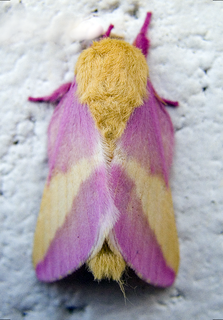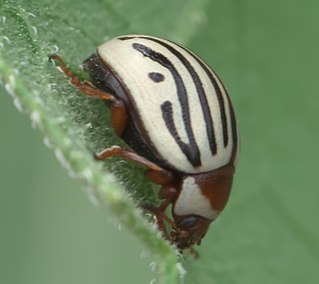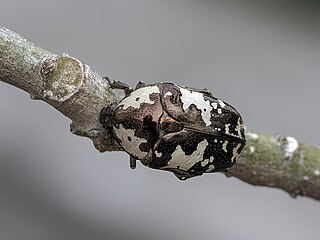
Silphidae is a family of beetles that are known commonly as large carrion beetles, carrion beetles or burying beetles. There are two subfamilies: Silphinae and Nicrophorinae. Nicrophorines are sometimes known as sexton beetles. The number of species is relatively small and around two hundred. They are more diverse in the temperate region although a few tropical endemics are known. Both subfamilies feed on decaying organic matter such as dead animals. The subfamilies differ in which uses parental care and which types of carcasses they prefer. Silphidae are considered to be of importance to forensic entomologists because when they are found on a decaying body they are used to help estimate a post-mortem interval.

The Colorado potato beetle, also known as the Colorado beetle, the ten-striped spearman, the ten-lined potato beetle, or the potato bug, is a major pest of potato crops. It is about 10 mm long, with a bright yellow/orange body and five bold brown stripes along the length of each of its elytra. Native to the Rocky Mountains, it spread rapidly in potato crops across America and then Europe from 1859 onwards.

The tansy beetle is a species of leaf beetle. It measures 7.7–10.5 mm in length and has a characteristic bright metallic green colouration. The common name derives from the tansy plant on which they often feed as both larvae and adults. In addition to the nominotypical subspecies, which repeats the specific name, C. graminis graminis, there are five further distinct subspecies of tansy beetle, which, collectively, have a Palearctic distribution, although in the majority of countries where it is found the species is declining. In the United Kingdom it is designated as 'Nationally Rare' and this localised population, centred on York, North Yorkshire, has been the subject of much recent research.

Dermestidae are a family of Coleoptera that are commonly referred to as skin beetles. Other common names include larder beetle, hide or leather beetles, carpet beetles, and khapra beetles. There are approximately 500 to 700 species worldwide. They can range in size from 1 to 12 mm. Key characteristics for adults are round oval shaped bodies covered in scales or setae. The usually clubbed antennae fit into deep grooves. The hind femora also fit into recesses of the coxa. Larvae are scarabaeiform and also have setae.

The rain beetles are a group of beetles found in the far west of North America. They spend most of their lives underground, emerging in response to rain or snow, thus the common name. Formerly classified in the Scarabaeidae, they are currently assigned to their own family Pleocomidae, considered the sister group to all the remaining families of Scarabaeoidea. The family contains a single extant genus, Pleocoma, and two extinct genera, Cretocoma, described in 2002 from Late Cretaceous deposits in Mongolia, and Proteroscarabeus of Late Cretaceous China.

Dryocampa rubicunda, the rosy maple moth, is a small North American moth in the family Saturniidae, also known as the great silk moths. It was first described by Johan Christian Fabricius in 1793. The species is known for its wooly body and pink and yellow coloration, which varies from cream or white to bright pink or yellow. Males have bushier antennae than females, which allow them to sense female pheromones for mating.

Actaeon beetle is a rhinoceros beetle of the family Scarabaeidae.

Xylotrupes gideon, the brown rhinoceros beetle, is a species of large scarab beetle belonging to the subfamily Dynastinae.

The European chafer is a beetle of the family Scarabaeidae. Formerly found only in continental Europe, this invasive species is now found at temperate latitudes in North America. The large, white grubs of A. majale feed on the roots of most cool-latitude grasses, both wild and cultivated. This has made the European chafer an enemy of lawns.

Lilioceris merdigera is a species of beetle belonging to the family Chrysomelidae, subfamily Criocerinae.

Lebia grandis is a ground beetle in the family Carabidae found in North America. It is a specialist predator on the eggs and larvae of Colorado potato beetles, and its larvae are obligate parasitoids of Colorado potato beetle pupae.

Sternocera aequisignata is a species of jewel beetles belonging to the subfamily Julodinae. Its bright metallic green elytra are frequently used jewellery making.

Zygogramma bicolorata, variously referred to as the Parthenium beetle or Mexican beetle, is a species of leaf beetle in the subfamily Chrysomelinae, native to Mexico.

Costelytra giveni, commonly known as New Zealandgrass grub, is a scarab beetle that is endemic to New Zealand and is a prevalent pasture pest.

Zygogramma exclamationis, commonly known as the sunflower beetle, is a species of leaf beetle belonging to the family Zygogramma. It is regarded as a pest of sunflower crops in North America.

Protaetia aurichalcea is a species of flower-chafer beetle in the family Scarabaeidae. It is found in Asia.

Harmonia octomaculata, commonly known as the large spotted ladybird, is a species of ladybird of the family Coccinellidae. It is found throughout India, Pakistan, Nepal, Bangladesh, Sri Lanka, Micronesia, and Australia.
Coelomera ruficornis is a species of beetle in the family Chrysomelidae. It is found in tropical South America where it feeds on Cecropia pachystachya trees.

Liatongus rhadamistus, or Scaptodera rhadamistus, is a species of dung beetle found in India, Sri Lanka, Laos and Thailand.
Platypria (Platypria) hystrix, is a species of leaf beetle found in India, China, Indonesia, Myanmar, Nepal, Sri Lanka, Thailand and Vietnam.



















